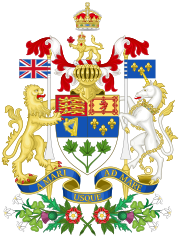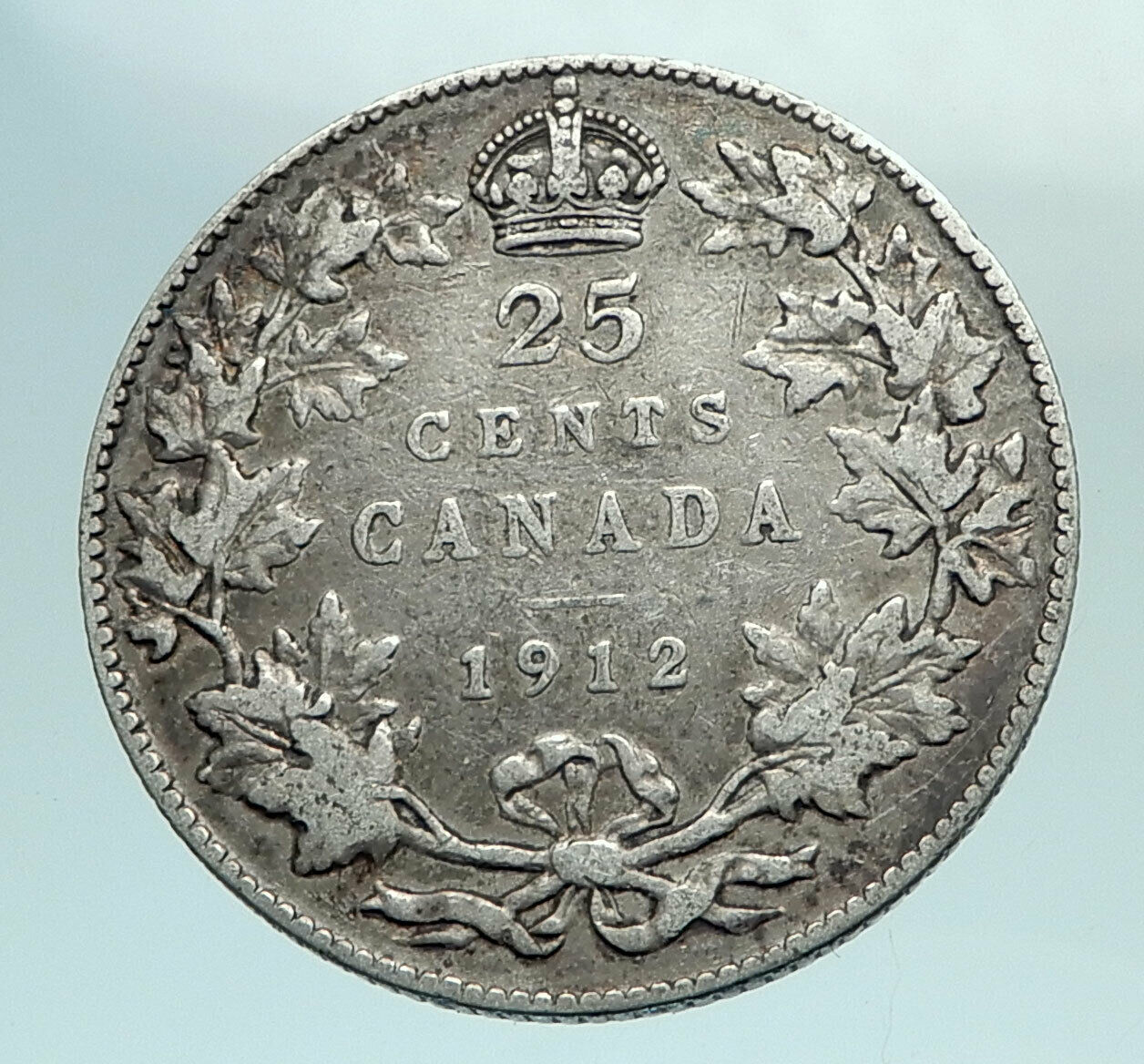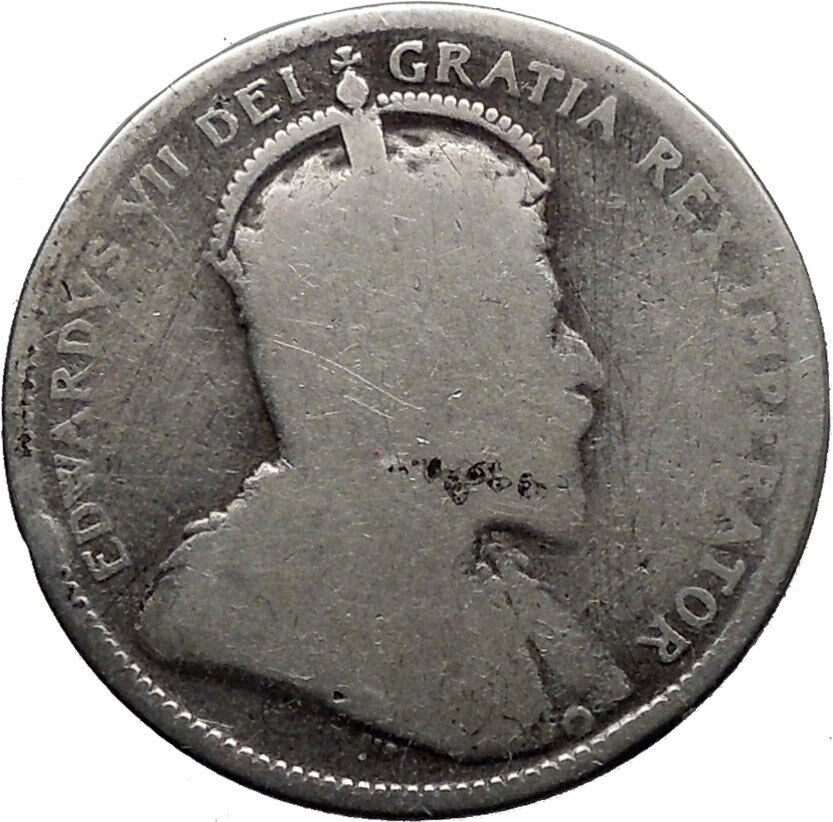|
Canada under George VI – King: 11 December 1936 – 6 February 1952
1940 25 Cents 23.5mm (5.68 grams) 0.800 Silver (0.1490 oz. ASW)
Reference: KM# 35 | Obverse Designer: T. H. Paget | Reverse Designer: Emanuel Hahn
GEORGIVS VI D:G:REX ET IND:IMP:, King George VI facing left.
◦ CANADA ◦ 25 cents, forepart of Caribou standing left.
You are bidding on the exact item pictured, provided with a Certificate of Authenticity and Lifetime Guarantee of Authenticity.
 A Caribou (North America) (Rangifer tarandus caribou, and other trinomials under Rangifer t.) is any of several North American subspecies, ecotypes, populations, and herds of the species Rangifer tarandus. In North America caribou vary in size from the smallest, the Peary caribou , to the largest, the boreal woodland caribou . The North American range of caribou extends from Alaska , through the Yukon , the Northwest Territories , Nunavut , into the boreal forest and south through the Canadian Rockies and the Columbia and Selkirk Mountains . Barren-ground, porcupine caribou and Peary caribou live in the tundra , while the shy woodland caribou, prefers the boreal forest. Two major subspecies in North America, the porcupine caribou and the barren-ground caribou form large herds and undertake lengthy seasonal migrations from birthing grounds, to summer and winter feeding grounds in the tundra and taiga . The migrations of porcupine caribou herds are among the longest of any terrestrial mammal. Barren-land caribou are also found in Kitaa in Greenland, but the larger herds are in Alaska, the Northwest Territories, and Nunavut. A Caribou (North America) (Rangifer tarandus caribou, and other trinomials under Rangifer t.) is any of several North American subspecies, ecotypes, populations, and herds of the species Rangifer tarandus. In North America caribou vary in size from the smallest, the Peary caribou , to the largest, the boreal woodland caribou . The North American range of caribou extends from Alaska , through the Yukon , the Northwest Territories , Nunavut , into the boreal forest and south through the Canadian Rockies and the Columbia and Selkirk Mountains . Barren-ground, porcupine caribou and Peary caribou live in the tundra , while the shy woodland caribou, prefers the boreal forest. Two major subspecies in North America, the porcupine caribou and the barren-ground caribou form large herds and undertake lengthy seasonal migrations from birthing grounds, to summer and winter feeding grounds in the tundra and taiga . The migrations of porcupine caribou herds are among the longest of any terrestrial mammal. Barren-land caribou are also found in Kitaa in Greenland, but the larger herds are in Alaska, the Northwest Territories, and Nunavut.
The circumpolar species itself, Rangifer tarandus, at a global level, is listed by the International Union for Conservation of Nature (ICUN) “as Least Concern due to a wide circumpolar distribution and presumed large populations.” The populations of subspecies, ecotypes, populations and herds of caribou in North America are in decline and one subspecies, the iconic boreal woodland caribou, has been listed by COSEWIC as threatened since 2002.
The George River caribou herd (GRCH), in the Ungava Peninsula of Quebec and Labrador in eastern Canada was once the world’s largest herd with 800,000–900,000 animals. By 2012 the herd numbered 27,600 and declined to 14,200 animals in 2014.
The meta-population of the more-sedentary subspecies R. t. caribou, or woodland caribou, spans the boreal forest of Canada from the Northwest Territories to Labrador. They are shy animals whose main food source is arboreal lichens of the mature forests and mainly live in marshes, bogs, lakes, and river regions. Since it takes hundreds of years for a biomass of tree lichen to be adequate to sustain boreal woodland caribou populations, deforestation has been a major factor in the decline of their numbers. The historic range of the boreal woodland caribou covered over half of present-day Canada, stretching from Alaska to Newfoundland and Labrador and as far south as New England , Idaho , and Washington . The smallest subspecies in North America, the Peary caribou is found in the High and Low Arctic, in the Northwest Territories (particularly, Banks Island) and in Nunavut (mainly Baffin Island).
The caribou is a specialist that is well adapted to cooler climates, with hollow-hair fur that covers almost all of its body including its nose, and provides insulation in winter and flotation for swimming. Caribou can reach a speed of 60–80 km/h (37–50 mph). Young caribou can already outrun an Olympic sprinter when only a day old. The caribou’s favourite winter food is fruticose deer lichen . Seventy percent of the diet of woodland caribou consists of arboreal lichen which take hundreds of years to grow and are therefore only found in mature forests.
Although there are many variations in colour and size, Canadian Geographic magazine states that in general, barren-ground caribou have larger antlers than the woodland caribou subspecies. Barren-ground caribou have large distinguishing white patches of fur that extend beyond the neck onto the back, a white muzzle and a face that is darker than the rest of the body. Their fur is sandy-beige in winter and light brown in summer. The woodland caribou have a wider more compact body and wider antlers. The coat is a rich dark brown in summer and dark grey in winter. Both the barren-ground and woodland caribou often have white “socks” above their hooves. On average the male weighs 90–110 kg (200–240 lb) and measures 0.9–1.7 m (3.0–5.6 ft) in shoulder height. The woodland caribou are the largest, and the Peary caribou are the smallest. The largest Alaskan male Porcupine caribou can weigh as much as 310 kilograms (680 lb).
Female caribou can live up to 17 years, and male caribou live about 13 years.
Both sexes grow antlers , though in some woodland caribou populations, the females lack antlers completely. Antlers are larger in males.
Caribou are an integral part of First Nations and Inuit oral histories and legends including the Gwich’in creation story of how Gwich’in people and the caribou separated from a single entity.

George VI (Albert Frederick Arthur George; 14 December 1895 – 6 February 1952) was King of the United Kingdom and the Dominions of the British Commonwealth from 11 December 1936 until his death. He was the last Emperor of India and the first Head of the Commonwealth .
As the second son of King George V , he was not expected to inherit the throne and spent his early life in the shadow of his elder brother, Edward . He served in the Royal Navy and Royal Air Force during the First World War , and after it took on the usual round of public engagements. He married Lady Elizabeth Bowes-Lyon in 1923 and they had two daughters, Elizabeth and Margaret .
George’s elder brother ascended the throne as Edward VIII upon the death of their father in 1936. However, later that year Edward revealed his desire to marry the divorced American socialite Wallis Simpson . British Prime Minister Stanley Baldwin advised Edward that for political and religious reasons he could not marry a divorced woman and remain king. Edward abdicated in order to marry, and George ascended the throne as the third monarch of the House of Windsor .
During George’s reign the break-up of the British Empire and its transition into the Commonwealth of Nations accelerated. The parliament of the Irish Free State removed direct mention of the monarch from the country’s constitution on the day of his accession. Within three years, the Empire and Commonwealth, except the Irish Free State, was at war with Nazi Germany . In the next two years, war with Italy and Japan followed. Though Britain and its allies were ultimately victorious, the United States and the Soviet Union rose as pre-eminent world powers and the British Empire declined. After the independence of India and Pakistan in 1947, George remained as king of both countries, but the title Emperor of India was abandoned in June 1948. Ireland formally declared itself a republic and left the Commonwealth in 1949, and India became a republic within the Commonwealth the following year. George adopted the new title of Head of the Commonwealth. He was beset by health problems in the later years of his reign. His elder daughter, Elizabeth, succeeded him.
 Canada is a country, consisting of ten provinces and t Canada is a country, consisting of ten provinces and t  hree territories, in the northern part of the continent of North America. It extends from the Atlantic to the Pacific and northward into the Arctic Ocean, covering 9.98 million square kilometres (3.85 million square miles) in total, making it the world’s second-largest country by total area and the fourth-largest country by land area . Canada’s common border with the United States forms the world’s longest land border. Canada is sparsely populated overall, the majority of its land territory being dominated by forest and tundra as well as the mountain range of the Rocky Mountains ; about four-fifths of the population live near to the southern border. The majority of Canada has a cold or severely cold winter climate, but southerly areas are warm in summer. hree territories, in the northern part of the continent of North America. It extends from the Atlantic to the Pacific and northward into the Arctic Ocean, covering 9.98 million square kilometres (3.85 million square miles) in total, making it the world’s second-largest country by total area and the fourth-largest country by land area . Canada’s common border with the United States forms the world’s longest land border. Canada is sparsely populated overall, the majority of its land territory being dominated by forest and tundra as well as the mountain range of the Rocky Mountains ; about four-fifths of the population live near to the southern border. The majority of Canada has a cold or severely cold winter climate, but southerly areas are warm in summer.
The land now called Canada has been inhabited for millennia by various Aboriginal peoples . Beginning in the late 15th century, British and French colonies were established on the region’s Atlantic coast. As a consequence of various conflicts , the United Kingdom gained and lost North American territories until left, in the late 18th century, with what mostly comprises Canada today. Pursuant to the British North America Act , on July 1, 1867, three colonies joined to form the autonomous federal Dominion of Canada. This began an accretion of provinces and territories to the new self-governing Dominion . In 1931, Britain granted Canada near total independence with the Statute of Westminster 1931 and full sovereignty was attained when the Canada Act 1982 severed the vestiges of legal dependence on the British parliament .
Canada is a federal parliamentary democracy and a constitutional monarchy , Queen Elizabeth II being the current head of state. The country is officially bilingual at the federal level. It is one of the world’s most ethnically diverse and multicultural nations, the product of large-scale immigration from many countries, with a population of approximately 35 million as of 2015. Its advanced economy is the eleventh largest in the world , relying chiefly upon its abundant natural resources and well-developed international trade networks. Canada’s long and complex relationship with the United States has had a significant impact on its economy and culture.
Canada is a developed country and one of the wealthiest in the world, with the tenth highest nominal per capita income globally, and the eighth highest ranking in the Human Development Index . It ranks among the highest in international measurements of government transparency, civil liberties, quality of life, economic freedom, and education. Canada is a Commonwealth Realm member of the Commonwealth of Nations , a member of the Francophonie , and part of several major international and intergovernmental institutions or groupings including the North Atlantic Treaty Organization, the G8 , the Group of Ten , the G20 , the North American Free Trade Agreement and the Asia-Pacific Economic Cooperation forum.
|





 A Caribou (North America) (Rangifer tarandus caribou, and other trinomials under Rangifer t.) is any of several North American subspecies, ecotypes, populations, and herds of the species Rangifer tarandus. In North America caribou vary in size from the smallest, the Peary caribou , to the largest, the boreal woodland caribou . The North American range of caribou extends from Alaska , through the Yukon , the Northwest Territories , Nunavut , into the boreal forest and south through the Canadian Rockies and the Columbia and Selkirk Mountains . Barren-ground, porcupine caribou and Peary caribou live in the tundra , while the shy woodland caribou, prefers the boreal forest. Two major subspecies in North America, the porcupine caribou and the barren-ground caribou form large herds and undertake lengthy seasonal migrations from birthing grounds, to summer and winter feeding grounds in the tundra and taiga . The migrations of porcupine caribou herds are among the longest of any terrestrial mammal. Barren-land caribou are also found in Kitaa in Greenland, but the larger herds are in Alaska, the Northwest Territories, and Nunavut.
A Caribou (North America) (Rangifer tarandus caribou, and other trinomials under Rangifer t.) is any of several North American subspecies, ecotypes, populations, and herds of the species Rangifer tarandus. In North America caribou vary in size from the smallest, the Peary caribou , to the largest, the boreal woodland caribou . The North American range of caribou extends from Alaska , through the Yukon , the Northwest Territories , Nunavut , into the boreal forest and south through the Canadian Rockies and the Columbia and Selkirk Mountains . Barren-ground, porcupine caribou and Peary caribou live in the tundra , while the shy woodland caribou, prefers the boreal forest. Two major subspecies in North America, the porcupine caribou and the barren-ground caribou form large herds and undertake lengthy seasonal migrations from birthing grounds, to summer and winter feeding grounds in the tundra and taiga . The migrations of porcupine caribou herds are among the longest of any terrestrial mammal. Barren-land caribou are also found in Kitaa in Greenland, but the larger herds are in Alaska, the Northwest Territories, and Nunavut.

 Canada is a country, consisting of ten provinces and t
Canada is a country, consisting of ten provinces and t  hree territories, in the northern part of the continent of North America. It extends from the Atlantic to the Pacific and northward into the Arctic Ocean, covering 9.98 million square kilometres (3.85 million square miles) in total, making it the world’s second-largest country by total area and the fourth-largest country by land area . Canada’s common border with the United States forms the world’s longest land border. Canada is sparsely populated overall, the majority of its land territory being dominated by forest and tundra as well as the mountain range of the Rocky Mountains ; about four-fifths of the population live near to the southern border. The majority of Canada has a cold or severely cold winter climate, but southerly areas are warm in summer.
hree territories, in the northern part of the continent of North America. It extends from the Atlantic to the Pacific and northward into the Arctic Ocean, covering 9.98 million square kilometres (3.85 million square miles) in total, making it the world’s second-largest country by total area and the fourth-largest country by land area . Canada’s common border with the United States forms the world’s longest land border. Canada is sparsely populated overall, the majority of its land territory being dominated by forest and tundra as well as the mountain range of the Rocky Mountains ; about four-fifths of the population live near to the southern border. The majority of Canada has a cold or severely cold winter climate, but southerly areas are warm in summer.




